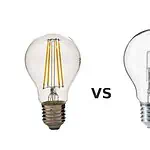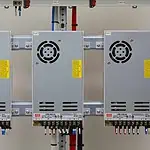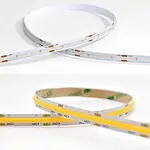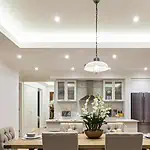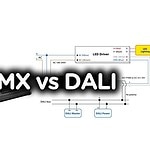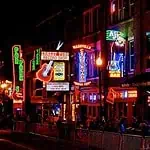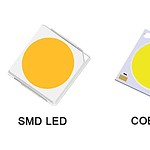Recessed lights are built-in fixtures directly installed in the ceiling/surface. These lights can be of two types- IC-rated and non-IC-rated ones. But what do these ratings mean, and what is their difference?
IC and non-IC ratings determine whether you can use a fixture on an insulated surface. The recessed lightings with IC ratings are suitable for insulated ceilings. These are airtight, cost-effective, and easy to install. In contrast, non-IC-rated recessed lights are not ideal for insulated surfaces. They have holes in them, which transfer heat directly to the insulator, resulting in fire breakouts. However, these are suitable for uninsulated walls.
In this article, I’ll explore all the differences between IC and non-IC-rated recessed lights. You will also know their usage and find the best-recessed light for your apartment. So, let’s begin-
What Is IC-Rated Recessed Light?
IC rating stands for Insulation Contact. It is a measurement of determining the capability of a light fixture to have direct contact with insulation. So, the recessed lights suitable to come in contact with insulation are known as IC-rated recessed lights. These lights have a range from 75 to 100 watts. They have an advanced thermal protection system that resists the fixture from getting overheated. And so you can use IC-rated recessed light with an insulator like- cellulose without the danger of fire breakouts.
Nowadays, most houses have insulation coating in the ceiling and walls. This keeps your home cool in summer and hot in winter. But the concern is with their explosive properties. Downlights get extremely hot while operating. And when you install downlights like recessed lights in an insulated ceiling, it can be hazardous. For example- Halogen lights may reach temperatures of up to 300°C, which is dangerous when used near combustible materials. So, installing such lighting in an insulated wall creates a risk of a fire breakout.
To prevent such accidents, you must have IC-rated recessed lighting. These lights cut down the risk of uncertain accidents caused due to overheating of recessed lights. When the recessed lights start overheating, IC-rated bulbs’ thermal protection automatically turns off the lighting. Thus, these ratings ensure the downlight is safe from fire risks, so you can easily install them in insulated ceilings and walls.
| Pros | Cons |
| Suitable for both insulated and uninsulated surface Energy-efficient Automated thermal protectionDoesn’t get overheated Easy installationAirtight/doesn’t have holes Safe/ no fire hazards | Limited wattage Fixtures are expensive |
What Is Non-IC Rated Recessed Light?
Non-IC-rated recessed lightings are the ones with a single can and holes for ventilation. These fixtures don’t have a proper thermal protection system. So they quickly get overheated. For this reason, they are not suitable for use on insulated surfaces.
These types of recessed lights are ideal for areas where no insulation is required. So, installing this lighting where its heat can quickly dissipate in the air will work fine. But if you install them on an insulated surface, they bring a high risk of fire hazard. Besides, it can affect the light’s durability or permanent failure and cause ceiling discoloration.
| Pros | Cons |
| Suitable for uninsulated surfacesAffordableAllows high wattagesSupports higher lumen ratings | Not ideal for insulated surfacesEasily gets overheatedNo automated thermal protection is availableUse more energyHas fire hazards |
How IC & Non-IC Rated Recessed Lights Work?
The working mechanisms of IC and non-IC-rated engines are quite different. IC-rated recessed lights have a double-can structure called “Can within Can.” And the gap between these two cans works as an insulation media. How’s that? When the inner can get hot, the insulation effect from the gap between them keeps the outer can cooler. So, you can install this lighting directly in the insulation without the risk of combustion.
In contrast, non-IC-rated recessed lights have a single can with holes for ventilation. So, when it gets overheated, the slits or holes transfer to the surrounding atmosphere. Installing these fixtures is unsuitable for an insulated surface as they transfer the heat directly to flammable materials like- Rockwool, cellulose, etc. This situation can be hazardous, causing massive fire breakouts. Therefore, non-IC-rated lights are suitable only for uninsulated and open spaces. However, you can reduce the risk by placing them at least 3 inches below the insulated ceilings. This further requires a covering around the fixture.
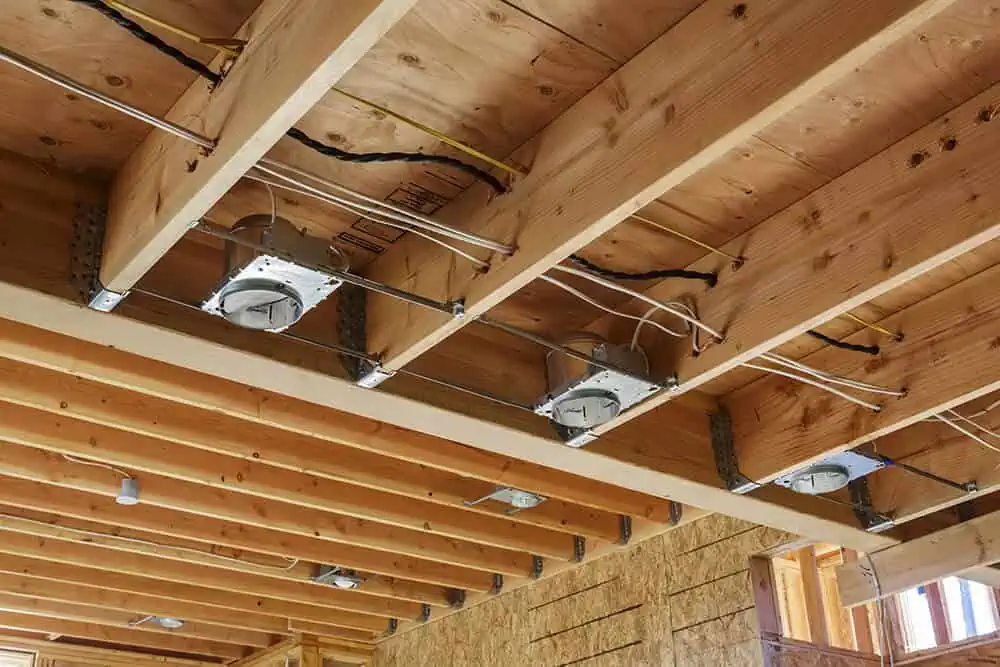
How To Identify IC Vs. Non-IC Rated Recessed Lights?
The recessed lights on your ceiling can be either IC rated or non-IC-rated. But how will you identify them? If you have an insulated house, then it’s essential to ensure you have IC-rated lights. Anyhow they are not IC rated; these small fixtures can be the reason for a big accident. So, here are the steps to identify an IC or non-IC-rated recessed light-
1. Examine The Light Fixture
First, trim around the fixture and remove the lightbulb to check whether your recessed lights are IC-rated. And now, take a flashlight to investigate the inner section of the recessed light.
2. Read The Label
Next, look for the label inside the light fixture. Usually, an IC-rated recessed light has an ‘IC’ marking with the label number. And the non-IC rated light fixtures have a ‘NON-IC’ label. Besides these markings, you will also find the wattage of the bulb. However, if your light fixture has no markings, no worries; there are other ways to identify them.
3. Holes & Slit Inspection
If you find any holes or slits in the recessed lightings, identify them as Non-IC rated fixtures. These lights are old models that have no thermal protection system. So, to prevent the lights from overheating, they come with holes and slit through which heat disperses in the air space. And for such a formation, they are not suitable for installation in insulated ceilings. But if you find no holes/ slits, count them as IC-rated fixtures. They have no cavity for air leakage and can be used on insulated surfaces.
4. Color Check
The easiest way to check whether the recessed light is IC or non-IC rated is its color. Usually, the IC-rated recessed lights are silver in color. In contrast, the non-IC-rated recessed lights are white.
| IC-Rated | Non-IC Rate |
| Silver | White |
However, this identification method is not fully proven. So, if you still need clarification regarding these, contact a professional. And if the lightings are non-IC rated, replace them with the IC-rated ones ASAP.
5. Lighting Check
Another way to determine if your recessed fixtures are IC rate is by checking the lighting. Turn on the recessed lights, and if you find light glowing from the ventilation holes of your home, then these are non-IC rated. But if such light emission is not found, these are air-tight and IC-rated.
In these ways, you can identify whether your recessed lights are IC or non-IC-rated.
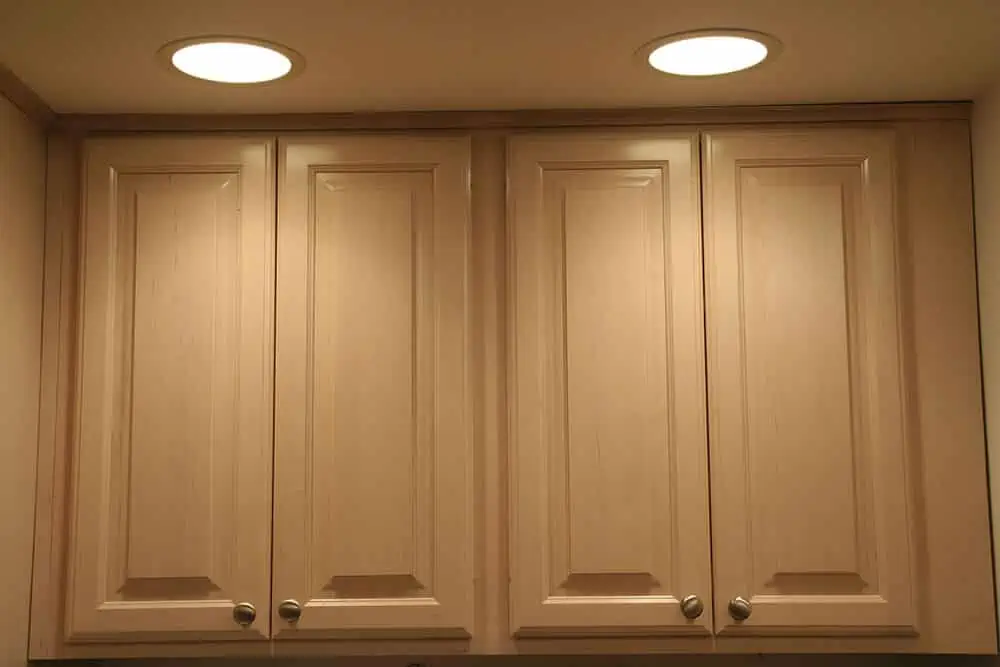
Comparison Chart – IC & Non-IC Rated Recessed Light Fixtures
Recessed lights can be divided into two types- IC rated & non-IC-rated. Here are the differences between these two types of recessed lighting-
| IC Rated Recessed Light | Non-IC Rated Recessed LIght |
| IC-rated recessed lights are suitable for installation on insulated surfaces. | Non-IC-rated recessed lights are not ideal for insulated surfaces. |
| IC-rated recessed lighting has a double can structure. | Non-IC rated lights have a single can structure with holes. |
| The IC-rated recessed lights have a limited wattage, ranging from 75 to 100 watts. | The recessed lights with no IC rating can have wattage as high as 150 watts. |
| These lights don’t have holes or slits. | They have holes or slits for heat dissipation. |
| You can install them in attic ceilings without keeping any gaps. | There must be at least 3 inches between the ceiling and the non-IC-rated light fixture. |
| These lights don’t create condensation buildup problems as they are airtight. | Non-rated recessed lights are not airtight, so they can create moisture condensation buildup issues. |
| IC-rated fixtures have an automated thermal protection system. | No automated thermal protection system is available for non-IC-rated recessed lights. |
| These lights are energy-efficient. | They use more energy. |
| The color of the IC-rated recessed light is silver. | The non-IC-rated recessed lights are white. |
| These types of recessed lights produce minimal heat while operating. | Recessed lights without IC ratings easily get overheated. |
| IC-rated recessed lights are safer as they have no fire-hazardous issues. | Insulators are highly flammable, so when non-IC-rated recessed lights are installed, they can cause fire breakouts. |
| Brighter or stronger light bulbs are not allowed for IC ratings as they can get overheated. However, LED lights are suitable for IC-rated recessed lights. | Non-IC-rated recessed lights support high-powered bulbs with higher lumen ratings. |
| When the IC-rated recessed lights start overheating, the system shuts off the lighting. | The non-IC-rated recessed lights don’t get shut off when overheated. They instead disperse heat to the surrounding air through holes in them. In case there are any obstacles, it causes fire to break out. |
Differences Between IC & Non-IC Rated Recessed Light Fixtures
So, these are the differences between IC and non-IC-rated recessed lights. However, to sum up, these lights can be differentiated based on four major factors, which are as follows-
Usage: You can use IC-rated recessed lighting in cellulose-insulated ceilings as they have an automated thermal protection system. These lights have a limited wattage that prevents the bulb from getting too hot. Yet if they get overheated, the thermal system automatically turns them off. But you can’t use non-IC-rated recessed lighting in a cellulose-insulated ceiling. These lights quickly get heated, causing fire breakouts in highly flammable substances like cellulose.
So, you can use IC-rated recessed lighting in insulated and uninsulated ceilings. But non-IC-rated recessed lights are suitable only for uninsulated surfaces.
Construction: Non-IC-rated recessed lightings have holes and slits. These holes are used for relieving heat when the bulbs get overheated. In contrast, IC-rated lights are airtight, with no gaps and slits.
Wattage: Another difference in these lightings is the wattage of bulbs. The IC-rated recessed lights use lower-wattage bulbs. But non-IC-rated bulbs can support both high and low-wattage bulbs. As a result, non-IC-rated lights are more compatible with brighter bulbs with higher lumen ratings.
Price: IC-rated recessed lights are usually more expensive than non-IC-rated ones. The reason is pretty simple. IC-rated lights give you better protection and ensure the safety that non-rated lights lack. So, these advanced features come for more pricing.
Therefore, now you know the differences between IC and non-IC-rated recessed lights. But which one is better? Check the below section to find that.
IC Vs. Non-IC Rated – Which Recessed Lighting Is Better?
Both IC and non-IC-rated recessed lights are used in architectural buildings. But when the question comes to finding the better one, you should consider multiple aspects. These are-
Geographical Location
You might be shocked that geographical location directly or indirectly relates to these IC and non-IC-rated concepts. In cold countries like- America, Norway, and Germany, houses are built with insulation systems to prevent heat loss. The walls and ceilings of their homes have a coating of glass wool, rockwool, polyester, or cellulose. These insulation materials store heat and keep the house at a comfortable temperature. Again in counties with hot climates, fiberglass works best for house insulation. If you are from these regions where homes have insulated structures, then IC-rated recessed lights are best.
However, less developed or counties with moderate climates don’t have insulated houses. For example- houses in China or Bangladesh don’t have insulation. Besides, insulating your house is very costly. So, for such places, non-IC-rated lights are ok. Yet, you can install IC-rated lights also.
Thermal Protection
IC-rated recessed lights have a thermal protection system that can monitor the heat production in the fixture. With this feature, when the light gets overheated, it automatically turns off. But non-IC-rated recessed lights don’t have an automated thermal system. So, they get overheated easily and have risks of fire breakout in contact with insulators.
Safety and Affordability
Non-IC-rated recessed lights have higher fire breakout risks than IC-rated ones. Thus, IC-rated lights are better considering the safety of uses on insulated walls.
In terms of affordability, non-IC-rated light fixtures are cheaper. In contrast, IC-rated lights are costly as they have advanced thermal systems.
Compatibility with Brighter Light Bulb
Regarding bulbs with higher wattage and brighter illumination, non-IC-rated recessed lights excels. They don’t have any wattage limitation as the IC-rated ones. So, if you have an uninsulated house and require brighter recessed lights, you can go for non-IC-rated lights.
Easy-Installation and Energy Efficiency
The installation process of IC-rated recessed lights is simple. Besides, it takes less time and saves electricity. In contrast, non-IC-rated recessed lights take more time to install. To install these lights, you need to remove the insulations first, which takes much effort.
The IC-rated light fixtures are airtight and have a limited wattage range. That is why they use less energy, and so they are cost-effective. On the other hand, non-IC-rated lighting is not airtight. So, they leak air and cause overheating. This eventually increases energy consumption.
Decision?
Analyzing all the above factors, we can decide that IC-rated recessed lights are better for insulated and uninsulated houses.
For insulated houses, non-IC-rated recessed lights are hazardous; in that sense, IC-rated is better. But Why are they good for uninsulated homes too? To deeply analyze, though these lights are expensive, they have a low energy consumption rate. Besides, non-IC-rated lights often have moisture condensation issues that you must fix. But with IC-rated lights, you will not face these issues.
So, eventually, using IC-rated lighting, you can save both your electricity bill and maintenance costs. But if you have an uninsulated house and don’t want to spend much on lighting, you can go for non-IC ratings. They are very affordable in comparison to IC-rated ones & also compatible with higher-wattage bulbs.
Can You Use Non-IC Rated Recessed Lights In Insulated Ceiling?
From the above discussions, you already know that non-IC-rated recessed lights are unsuitable for insulated surfaces. But is there any way to safely use them with insulation?
The answer is yes. Non-IC-rated recessed lights are cheaper and can be used with high-wattage bulbs. But the major problem with these is the holes that disperse heat, which is hazardous for an insulated ceiling. But there is a way to solve this issue. Use an airtight cover to prevent the fixture from contacting the insulator. You will find these covers readymade. However, making a DIY cover using rigid foam insulation will also work. But make sure it is made out of fire-rated materials. Additionally, you must remember to keep a minimum of 3 inches of space between the light’s metal housing and any other object.
Advantages Of Recessed Lighting
Recessed lights are a popular category of downlights, ideal for residential and commercial purposes. Here are the reasons/ benefits which make these fixtures so popular-
- Space Illusion: Recessed light is excellent for creating an illusion of space. Adding numerous recessed lights to the ceiling adds a dimension to your space. These lights work great for narrow areas like a walking passage or hallway. They can make these small rooms look bigger.
- Accent Lighting: Besides ambient lighting, you can also use recessed lights for accent lighting. If you want to highlight the texture of your walls or any artwork, these lights would be excellent.
- Even Lighting: Installing traditional lighting doesn’t provide even lighting. It lightens up only the area near it. In contrast, several recessed lights are placed in different ceiling areas, resulting in equal lighting in all corners. Besides, the fixtures remain hidden in the wall. Thus, it doesn’t disturb you with direct light glaring issues.
- Lightweight: Recessed lights are very lightweight and small in size. And these features make them suitable for attaching directly to the drywall.
Drawbacks of Recessed Lighting
Besides numerous benefits, recessed lights also have some disadvantages. These are as follows-
- High cost: Ambient lighting with traditional light, like, a tube or bulb, requires only one fixture. But when lighting is recessed, one is never enough. You need to install several fixtures. This ultimately multiplies your lighting cost by many times.
- Permanent fixture: Recessed lights are built-in fixtures that are attracted to the ceiling. So, you can’t change these lights once installed.
- Complex Installation: Installing recessed light has to go through a complicated process. You need to make several holes in the ceiling, which requires professionals. And if you have insulated walls, the procedure becomes much more difficult.
- Unsafe (Non-IC Rated lightings): Using non-IC rated recessed lightings to the insulated ceilings can be very dangerous. This can cause a high risk of fire breakouts.
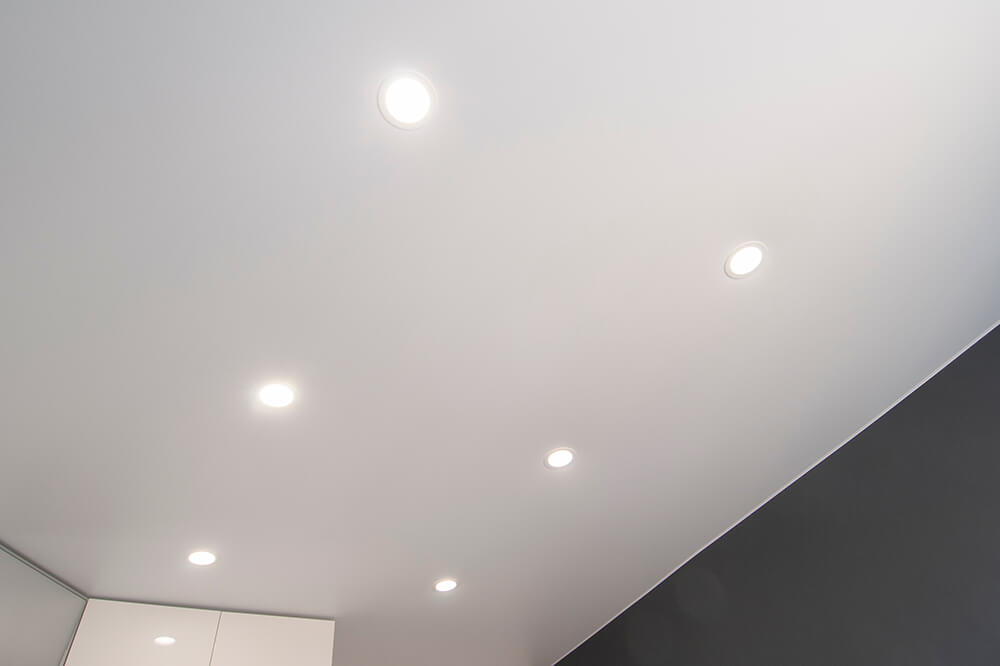
FAQs
IC stands for Insulation Contact. A recessed light with an IC rating indicates the fixture is suitable for installation on an insulated surface.
By looking at the inner section of the recessed lights, you can quickly check if it is airtight. Take a flashlight and direct it into the light fixture. If you find bunches of holes inside, it is not airtight. However, you can confirm it in another way. Turn on the light, and check if the light glows on the attic side. If not, it’s airtight.
Installing non-rated recessed lights on an insulated surface can be very dangerous. These lights have small holes that release heat to the surrounding atmosphere. So, when used on an insulated surface like cellulose, these lights release heats directly to the flammable insulator. And due to such overheating can cause fire breakouts.
No, IC-rated lights and fire-rated lights are not the same. IC-rated lights prevent fire on the insulated surface. In contrast, fire-rated lights are designed to reduce the spread of an existing fire. These lights are installed in recessed or semi-recessed holes and are equipped with an intumescent pad. The pad expands and blocks the light holes when the fire breaks out. Thus, it doesn’t let the fire reach the above floor through the ceiling.
To use non-IC-rated recessed lighting on an insulated surface, first remove the insulation around it. Cover the fixture with a fire-rated material that prevents direct contact with the insulation. In this way, you can insulate non-IC-rated recessed lights. But remember to keep a 3-inch gap from all sides of the can light.
Yes, IC-rated lights are safe. They have a dual can structure that creates an insulation effect preventing overheating. Besides, they have an automated thermal protection system. With this system, the lights automatically shut off once they get overheated. Thus they have minimal fire breakout risks.
No, all LED recessed lights are not IC-rated. They can be both IC and non-IC rated. The LED recessed light that has a hole inside it is non-IC rated. And the ones without holes or which are airtight are IC-rated.
LED recessed lights run in much cooler temperatures than incandescent bulbs. Still, the external heatsink and other electrical components get quite hot. So, keep a safe distance between the LEDs and the insulation. But if the LED recessed light is IC-rated, it can touch the insulation.
Final Thought
The main difference between IC and non-IC-rated recessed lighting is in their usage. You can use IC-rated fixtures in insulated surfaces, but non-IC-rated ones can’t. Besides, they have some differences in their construction and brightness also.
IC-rated ones are better in these two recessed lights as they are free from fire hazards. Additionally, these fixtures are energy efficient and save your electricity bills. However, non-IC-rated recessed lights are also ok, but only for uninsulated surfaces.
LEDYi manufactures high-quality LED strips and LED neon flex. All of our products go through high-tech laboratories to ensure the utmost quality. Besides, we offer customizable options on our LED strips and neon flex. So, for premium LED strip and LED neon flex, contact LEDYi ASAP!
